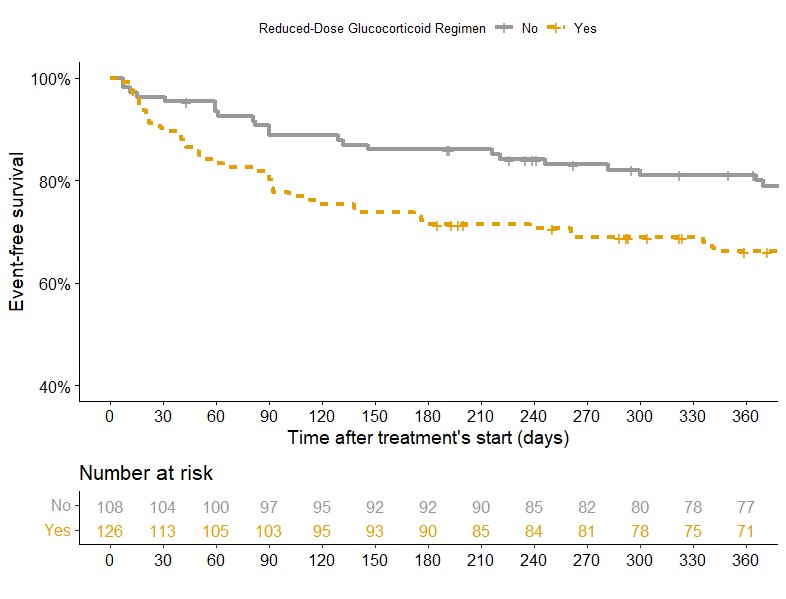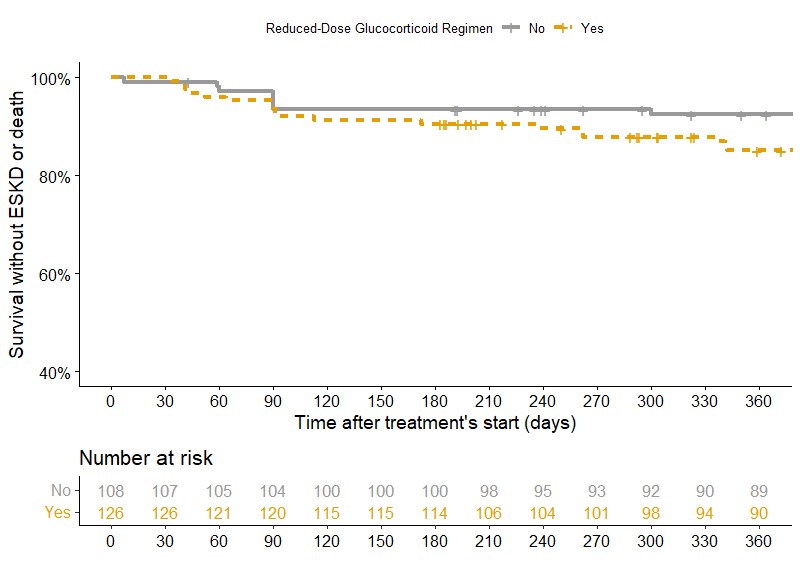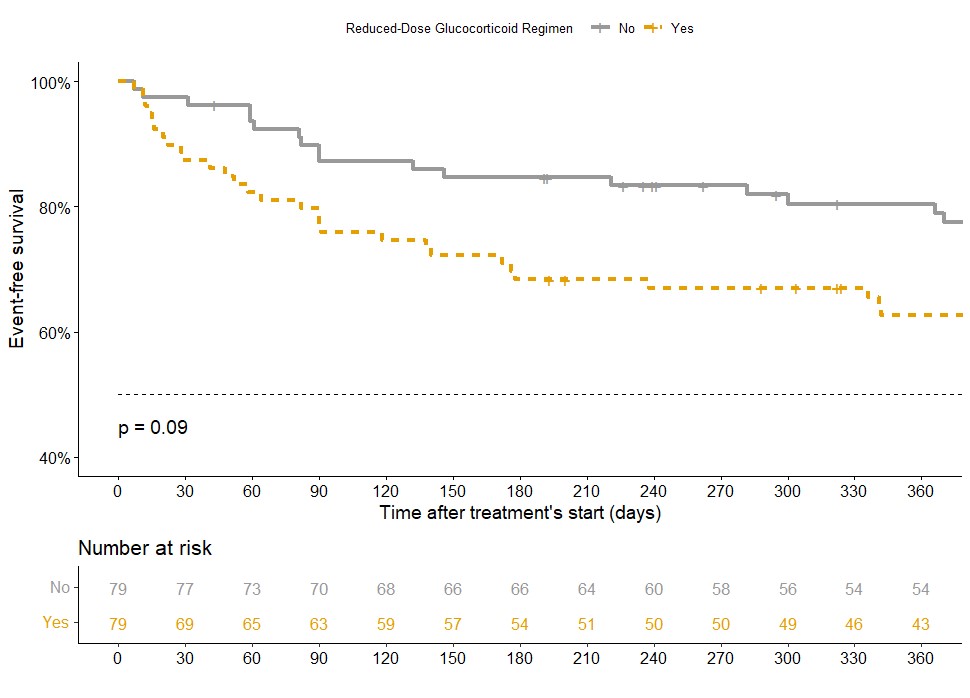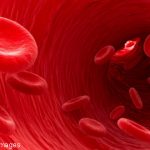SAN DIEGO—In a study titled Real-Life Use of the PEXIVAS Reduced-dose Glucocorticoid Regimen in Granulomatosis with Polyangiitis and Microscopic Polyangiitis, Nagle et al. evaluated the efficacy and safety of the reduced-dose glucocorticoid regimen in a real-world setting.
Background/Purpose
Glucocorticoids (GCs) in combination with rituximab (RTX) or cyclophosphamide are the cornerstone of treatment for patients with severe granulomatosis with polyangiitis (GPA) and microscopic polyangiitis (MPA). GCs are associated with adverse effects, including serious infections. The PEXIVAS trial demonstrated non-inferiority of reduced-dose GC regimen compared to standard dose for the incidence of death or end-stage kidney disease (ESKD), with a significant reduction in serious infections at one year. However, the primary endpoint did not include disease progression or relapse, the majority of patients received cyclophosphamide as induction therapy, and subgroup analysis showed a trend towards an increased risk of death or ESKD in RTX-treated patients.
Methods
Nagle et al. conducted a retrospective, multicentre study comparing the PEXIVAS reduced-dose GC regimen with a standard regimen in patients with severe GPA or PAM flare between January 2018 and April 2022. The primary composite endpoint included the occurrence of death, ESKD, progression before remission requiring treatment modification or relapse, whichever occurred first. Factors associated with the occurrence of the primary endpoint and of death or ESKD (i.e. the PEXIVAS endpoint) were estimated using univariate and multivariate Cox models. In a sensitivity analysis, patients treated with reduced-dose and standard-dose GCs were compared after matching on a propensity score.
Results
Of the 234 patients enrolled (93 MPA and 148 GPA), 126 (53.8%) received a reduced GC regimen and 108 (46.2%) received a standard regimen. The primary endpoint occurred in 62/234 (26.5%) of patients during the first year of follow-up: 33.3% of patients on the reduced dose versus 18.5% on the standard dose (p=0.016).
In multivariate analysis, a reduced GC regimen was significantly associated with the occurrence of the endpoint compared to a standard regimen (HR 1.72; 95%CI 1.08-2.74) (Figure 1), but was not associated with an increased risk of death or ESKD (HR 1.62; 95%CI 0.82-3.19) (Figure 2). There was no significant difference in serious infections at 1 year (20.6% vs 15.7%, p=0.427).
After propensity score matching, the reduced-dose GC regimen tended to be more likely to meet the primary endpoint than the standard regimen (HR 1.57; 95%CI 0.93-2.64) (Figure 3). In the subgroup of patients treated with the reduced-dose GC regimen, patients with creatinine levels above 300 μmol/L were more likely to meet the primary endpoint (RR 2.14; 95% CI 1.14-4.03). Similarly, in the subgroup of patients treated with RTX, the reduced-dose GC regimen tended to be more likely to achieve the primary endpoint (HR 1.61; 95% CI 0.94-2.77) and was more likely to meet death or ESKD (HR 2.42; 95%CI 1.04-5.66).
Conclusion
In patients with severe GPA or MPA, the reduced-dose GC regimen was associated with an increased risk of death, ESKD, progression before remission requiring treatment modification or relapse. This risk was even greater in patients with creatinine levels above 300 μmol/L and in those treated with RTX as induction therapy.

Kaplan-Meier survival curve comparing occurence of primary endpoint at 12 months between patients treated with reduced-dose GC regimen (Yes: orange) and patients treated with standard-dose regimen (No: grey) during the first year of follow-up

Kaplan-Meier survival curve comparing occurence of death or ESKD at 12 months between patients treated with reduced-dose GC regimen (Yes: orange) and patients treated with standard-dose regimen (No: grey) during the first year of follow-up

Kaplan-Meier survival curve comparing occurence of primary endpoint at 12 months between patients treated with reduced-dose GC regimen (Yes: orange) and patients treated with standard-dose regimen (No: grey) during the first year of follow-up, after matching with a propensity score
Disclosures
S. Nagle: None; Y. Nguyen: None; X. Puéchal: None; D. Titeca-Beauport: None; T. Crépin: None; R. Mesbah: None; I. Boudhabhay: None; G. Pugnet: None; J. Woessner: None; R. Outh: None; C. Lebas: None; A. Néel: None; a. Karras: AstraZeneca, 6, GlaxoSmithKlein(GSK), 4, Novartis, 2, Pfizer, 6; E. Hachulla: None; B. Subran: None; P. Kerschen: None; M. Gerfaud-Valentin: None; S. Vinzio: None; T. Goulenok: None; R. Borie: None; S. Humbert: None; Y. Uzunhan: None; S. Melboucy-Belkhir: None; J. Gouin: None; M. Guerry: None; B. Terrier: AstraZeneca, 5, CSL Vifor, 2, GlaxoSmithKlein(GSK), 2.
Nagle S, Nguyen Y, Puéchal X, Titeca-Beauport D, Crépin T, Mesbah R, Boudhabhay I, Pugnet G, Woessner J, Outh R, Lebas C, Néel A, Karras a, Hachulla E, Subran B, Kerschen P, Gerfaud-Valentin M, Vinzio S, Goulenok T, Borie R, Humbert S, Uzunhan Y, Melboucy-Belkhir S, Gouin J, Guerry M, Terrier B. Real-life use of the PEXIVAS reduced-dose glucocorticoid regimen in granulomatosis with polyangiitis and microscopic polyangiitis [abstract]. Arthritis Rheumatol. 2023;75(suppl 9).


